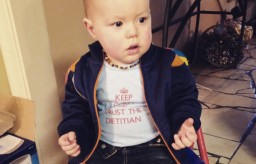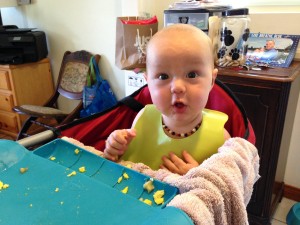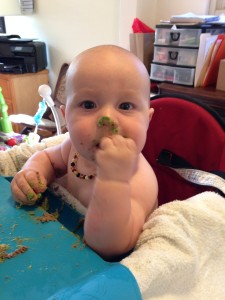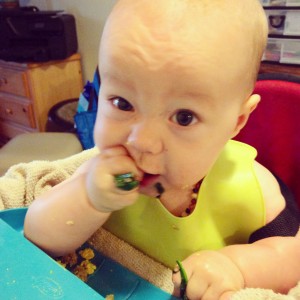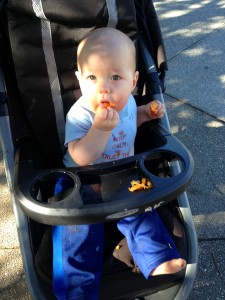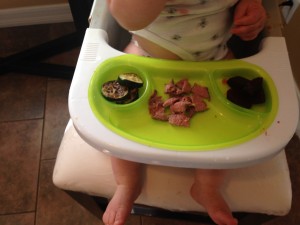I never spoon-fed my baby. I never bought baby food. Before I go into the details of how I went and continue to go about feeding Caleb, I want to preface by saying I’m writing this article to merely share what we did. Please do not feel bad if you didn’t do it this way or you don’t plan on it. As I fellow mama, I know we often compare ourselves to other mamas and families and can be overly hard on ourselves. So, please read with a gentle heart and open mind.
1st 6 months. Caleb was exclusively breastfed. I’m not going to go into detail about all the benefits of breastfeeding, but one of the coolest things to me is how God created our bodies to produce the perfect food for our babies. It is the ideal combination of protein, fat, and carbs, while also containing immune-boosting factors and nutrients that help a baby’s body grow and remain strong.
The 1st few days of breastfeeding is actually not milk; it is colostrum. Not only does colostrum help get the bowels moving to pass early stools, it also signals the immune system in the gut to be up and running. This is important because babies are born with permeable gut linings, meaning they have holes in them that need to be closed in order to block harmful substances from leaking into the bloodstream. Colostrum helps initiate the production of good gut bacteria and enzymes in order to prepare the baby’s gut for food that will be arriving soon. It’s such a beneficial substance for the gut, it’s even being used to support gut healing in adults! Sorry, I just think it’s so cool.
While breastfeeding, I try to keep my diet as healthy as possible in order to nourish my stressed and nutrient-depleted body while also nourishing my baby. I try to stick to whole, real foods while still eating enough calories. While nursing, you did at least 300-500 extra calories.
Post-partum weight loss. Ok, so I’m going to be honest here, I thought I’d be back to my pre-pregnancy body in no time since I was breastfeeding. Right? That’s what we’re told. However, 1 year postpartum, I am still not. I had a very hard time with this, as I’m sure many other mamas do too. I know it’s different for everyone, but I just want to lovingly tell you to not worry about it like I did and just keep focusing on what’s most important during this time: to nourish a growing baby.
6-8 months. Ok, now on to the good stuff. Right at 6 months, I introduced solids while continuing to breastfeed. It is important to wait until 6 months because their digestive systems are still maturing. They are still working on healing the gut lining and producing enzymes necessary to digest food. I took a baby-led weaning approach, which basically means allowing Caleb to feed himself from the very beginning. You can find out more about baby led weaning here. I started slowly, introducing 1-2 foods at a time in order to watch for any allergies. I also started with 1 meal at a time. I did only breakfast for a week or so and then I started to do two meals/day (breakfast and dinner) and eventually 3 meals. And now he sometimes gets some snacks.
- 1. Egg yolks. I thought hard-boiling would be the best way to give him the yolk, but that was a little too dry. He did a lot better when I cooked them over-medium in ghee. Egg yolks are great because they contain choline and cholesterol, which help the brain and nervous system develop. I think he has had an egg yolk almost every single day since.
- 2. Banana. I tried not to give Caleb too much fruit at 1st because their small intestines aren’t ready to digest a lot of carbohydrate plus I didn’t want him to have a preference for sweet. However, bananas are an exception because they contain high amounts of amylase, which is the enzyme that breaks down starch. Warning: too many bananas can be constipating. More about that below.
- 3. Avocado. I cut these in slices so he could pick them up. Tip: cut little slits in the avocado, to make it easier to pick up.
- 4. Pureed meat. After doing eggs, avocado and banana for about 2 weeks, I introduced pureed meat. I put stewed beef or chicken plus liver (sometimes) plus a little bone broth in a food processor and pureed it. Meat is an excellent source of zinc and heme iron, which is better absorbed than iron from plant sources.
- 5. Cooked veggies: spinach, carrots, zucchini, sweet potatoes, broccoli,cauliflower, green beans, and beets. I introduced these around 7 months. I roast them in avocado or coconut oil or I steam them and add ghee and sea salt. I also like to make a cauliflower mash. It’s important to add fat (ghee, organic butter, avocado, or coconut oil) to veggies as it aids in the digestion of fat-soluble nutrients.
- Note on salt: Many books warn against giving salt to babies; however, salt contains trace minerals that are actually critical for digestion and brain development. Just make sure to use unrefined sea salt and only a pinch of it
- 7. Sprouted grain bread. There is a lot of controversy on when to introduce high-allergen foods, such as wheat, dairy, eggs, nuts, and shellfish. Some research suggests introducing it early on can help decrease the risk of allergies to it later. I took a conservative approach and introduced wheat around 7 months, nuts (in form of almond butter) around 8 months, dairy around 9 months, full eggs around 10 months, and shellfish around 11 months. However, I still try to limit his wheat intake.
8-10 months. I didn’t add a whole lot during these months. I just kept experimenting with different ways to prepare the foods. I tried to keep each meal fairly balanced by offering each of the following. Sometimes he cleans his plate, other times he picks and chooses what he wants. I try not to force it, even when it drives me nuts to see him skip the veggies 🙂
- 1. Protein: Meatballs or meatloaf work great as they are hard enough to pick up, but soft enough to chew. I would add veggies in them and did use a whole egg for the binder.
- 2. Non-starchy veggies: almost all were fair game. I just made sure they were soft enough.
- 3. Starchy veggies or squash: sweet potatoes, pumpkin, acorn squash, butternut squash, spaghetti squash
- 4. Fat: avocado, olives, coconut oil, butter or ghee
- 5. Fruit: this is the point I started to introduce more fruit. He loves fruit. Guess he has his mama’s sweet tooth 🙂 I try to give him fruit towards the end of the meal.
- 6. Dairy: I don’t do this at every meal, but I slowly introduced some dairy. I started with grassfed, full-fat, plain cow’s milk yogurt and goat’s milk yogurt. I then introduced some goat’s milk cheese and grassfed cheese.
- 7. Fermented veggies: I don’t do these at every meal, but I try to give him a little fermented pickles or sauerkraut, which provide good bacteria (probiotics).
10-12 months. The only new addition here was fish and shellfish. Fish should ideally be wild-caught. We did some salmon cakes, canned wild salmon, and fresh salmon. He has also tried some shrimp at a restaurant from a ceviche appetizer. At this point, he pretty much eats what we eat, which is mostly a paleo, whole-food diet.
Supplements. These are the supplements I give Caleb.
- 1. Vitamin D. The American Journal of Pediatrics recommends that infants receive 400 IU of vitamin D per day. Vitamin D is particularly important for their bone development and immune system. The best source of vitamin D is the sun, which is often limited in both babies and adults, so they often need to get their vitamin D from food (including breastmilk) and supplementation. I make sure to take vitamin D myself so he can get some from breastmilk, but I also give him 1,000 IU every couple of days. This is the brand I use for me and him.
- 2. Cod liver oil. Cod liver oil contains vitamin A and D as well as DHA and EPA, which are all important for growth and development. I started with a ¼ tsp every couple of days from 6-9 months and now give closer to ½ tsp every couple of days. This is the brand I use. I use the oslo orange flavor. NOTE: do not give via the syringe that comes with it or even by the spoonful as it can sting their throat (trust me I learned the hard way). Now, I just mix it with his food, such as yogurt or pumpkin puree.
- 3. Probiotics. Probiotics are really helpful for babies’ gut and immune system. They can be particularly helpful for babies with colic, reflux, and constipation. I use this brand. It is a higher dose, so I don’t use it daily. Caleb didn’t really have a lot of reflux, so I mostly give it to him when he’s constipated.
Tools. Here are a couple helpful items:
- 1. Portable placemat. This has suction cups and is rubber, so it’s easy to clean. Its also nice to take to restaurants
- 2. Rubber bibs. Easy to clean and little pouch catches some food.
- 3. Baby spoons. Caleb loves eating with spoons even if they aren’t being used for their purpose. At around 11 months he started to spoon food into his mouth.
- 4. Portable high-chair. Since we travel a lot, we needed something that was portable. We started with this one, which hooks to the table. Pro: he’s right up to the table so it creates a good environment that he’s eating with us. Con: the fabric is hard to clean and it’s really not that portable. We now use this one, sit on top of a chair. I like it a lot. Super easy to clean and transport.
- 5. A dog to clean up the mess 🙂
Constipation. It happens and is not fun. A couple of things that can contribute:
- 1. Introduction of solids. Their digestive systems are used to an all-liquid, highly digestible diet, so it takes a little time to adjust
- 2. Too much of these: bananas, applesauce, cereal, breads, pasta, rice, white potatoes
- 3. Not enough fiber from veggies
- 4. Excessive dairy
Here are some remedies:
- 1. Probiotics: There are trillions of bacteria in our digestive tract. When we poop, half of the weight is bacteria.
- 2. “P” fruits and veggies: peaches, plums, pears, prunes, peas. Spinach and apricots can also help
- 3. Water
- 4. Remove foods listed above
- 5. Tummy massage
- 6. Bicycle legs
- 7. Warm bath
I hope our first year feeding experience can provide guidance to anyone looking to do something similar with their baby. I chose this way of feeding Caleb because I feel it:
* Is the best way to offer Caleb nutritious foods
* Fits with our lifestyle and the way we eat
* Helps develop fine-motor skills
* Is cost-effective
* Is easy to do on the road and at restaurants
Please feel free to post any questions you may have. I’m happy to help!
Resources:
1. Kresser, Chris. Healthy Baby Code. http://healthybabycode.com/signup
2. Erlich, K. Genzlinger, K. Brownstein, D. Super Nutrition for Babies: The Right Way to Feed Your Baby for Optimal Health. Mar, 2012.
3. Rapley, Gill. Murkett, T. Baby-led Weaning: Helping Your Baby to Love Good Food. Dec, 2008.
4. Michaelis, K. Beautiful Babies: Nutrition for Fertility, Pregnancy, Breat-feeding and Baby’s First Foods. Mar, 2013.
5. Weston A. Price. Nourishing a Growing Baby. http://www.westonaprice.org/health-topics/nourishing-a-growing-baby/
6. Satter, E. Child of Mine: Feeding with Love and Good Sense. Mar, 2000.

